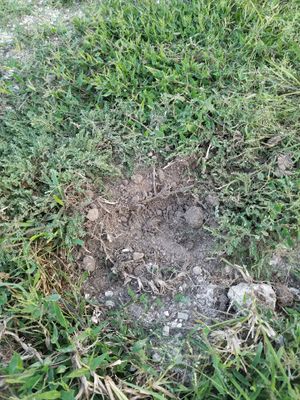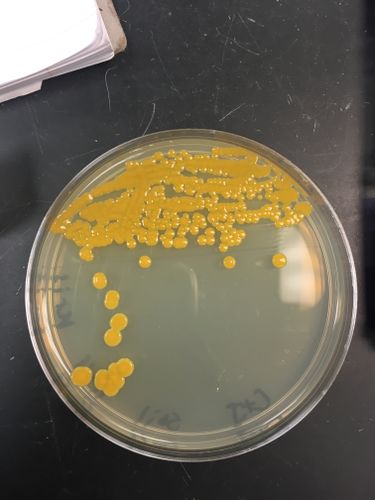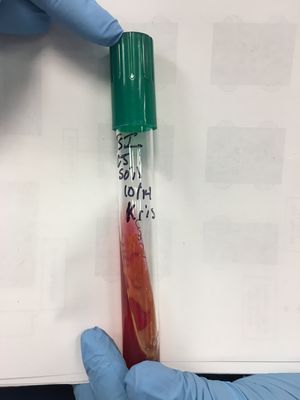B. Cereus Cudmore-Lewis: Difference between revisions
| (93 intermediate revisions by the same user not shown) | |||
| Line 2: | Line 2: | ||
==Classification== | ==Classification== | ||
Domain | Domain: Bacteria<br> | ||
Phylum: Firmicutes<br> | |||
Class: Bacilli<br> | |||
Order: Bacillales<br> | |||
Family: Bacillaceae <br> | |||
===Species=== | ===Species=== | ||
| Line 11: | Line 14: | ||
|} | |} | ||
'' | ''Bacillus cereus'' <br> | ||
[[File:sembcereus.png|300px|]]<br> | |||
''B. cereus under an electron microscope(7).'' | |||
==Habitat Information == | ==Habitat Information == | ||
'''Soil Sample Dig Location:'''<br>Lat:30.002092 <br>Long:-97.883009<br> | |||
Location:Lat:30.002092 Long:-97.883009 | Soil: Castephen Clay Loam/ 3-5% slopes, eroded<br> | ||
Description: New housing development, empty lot | Description: New housing development, empty lot<br> | ||
Precipitation:Not within 48 hours | Precipitation:Not within 48 hours<br> | ||
Temperature:70, few clouds | Temperature:70, few clouds<br> | ||
Depth: 1.25 inches | Depth: 1.25 inches<br> | ||
Visibility: 10 miles | Visibility: 10 miles<br> | ||
Humidity: 59% | Humidity: 59%<br> | ||
Wind: S 10 mph | Wind: S 10 mph<br> | ||
Sea Level: 1011.8 | Sea Level: 1011.8<br> | ||
Date & Time: September 8, 2016, 18:53 | Date & Time: September 8, 2016, 18:53<br> | ||
[[File:soil dig.jpg|300px|]] | |||
==Description and Significance== | ==Description and Significance== | ||
[[File:streak plate.jpg|375px|]] | |||
'''Description:'''<br> | |||
Color: Yellow (mustard-like color)<br> | |||
Form: Circular<br> | |||
Margin: Entire<br> | |||
Consistency: Semi-mucoid<br> | |||
Texture: Smooth<br> | |||
Elevation: Raised<br> | |||
*A standard Gram stain was performed on the sample to observe cellular morphology.<br> | |||
Gram reaction: positive<br> | |||
Cellular morphology: very small, clustered rods<br> | |||
<br>'''Antibiotics'''<br> | |||
Antimicrobial Activity: Negative<br> | |||
Drug Resistance: B. cereus produce large amounts of β lactamase and are resistant to penicillin, ampicillin, cephalosporins, trimethoprim(8).<br> | |||
'''Significance'''<br> | |||
''B. cereus'' can be considered significant in food manufacturing, livestock health, human disease, and pharmaceutical manufacturing. | |||
==Genome Structure== | ==Genome Structure== | ||
The genome of ''B. cereus'' is very similar to the genome of ''B. anthracis'' (3). ''B. cereus'' has a single, circular chromosome that is 5,411,809 nt long (4). | |||
<br> | |||
S Ribosomal sequences obtained from PCR: | |||
[[File:genes.jpg|400px|]] | |||
[[File:gelE.jpeg|375px|]] <br> | |||
''Gel Electrophoresis results from Microbiology class. Well 4 is ''B. cereus'' sample collected by Lewis and Cudmore.'' | |||
==Cell Structure, Metabolism and Life Cycle== | ==Cell Structure, Metabolism and Life Cycle== | ||
''B. cereus'' is a rod shaped, Gram positive bacteria. ''B. cereus'' is motile via flagella and produces endospores (6).<br> | |||
''B. cereus'' is a facultative anaerobe. Some metabolic molecules ''B. cereus'' makes include NADH dehydrogenases, succinate dehydrogenase, complex III, non-proton-pumping cytochrome bd quinol oxidases, and proton-pumping oxidases such as cytochrome c oxidase and cytochrome aa3 quinol oxidase (5). | |||
'''Other stain results:'''<br> | |||
Capsule stain: negative <br> | |||
Endospore stain: negative | |||
'''Additional Test Results:'''<br> | |||
Gelatinase Test: Positive for Gelatinase production<br> | |||
[[File:gels.jpg|300px|]]<br> | |||
Deoxyribonuclease Test: Positive for DNAse<br> | |||
[[File:dnase.jpg|300px|]]<br> | |||
Lipase Test: Negative<br> | |||
[[File:lipase.jpg|300px|]]<br> | |||
Starch Hydrolysis: Negative<br> | |||
[[File:starch.jpg|300px|]]<br> | |||
Citrate (Enteric) Test: Positive<br> | |||
[[File:citrate.jpg|300px|]]<br> | |||
Urea Test:Negative<br> | |||
[[File:urea.jpg|300px|]]<br> | |||
Methyl Red: Negative<br> | |||
Voges-Proskauer: Negative<br> | |||
[[File:mrvp.jpg|300px|]]<br> | |||
Blood Agar:(α)alpha (partial hemolysis) <br> | |||
[[File:ba.jpg|300px|]]<br> | |||
SIM Test:<br> | |||
*Sulfur-negative | |||
*Indole-positive | |||
*Motility-negative | |||
[[File:sim.jpg|300px|]]<br> | |||
Nitrate Test: Negative for Nitrate reduction<br> | |||
[[File:nitrate.jpg|300px|]]<br> | |||
Phenylalanine Deaminase Test: Negative<br> | |||
Phenol Red Test: | |||
*Lactose-Fermentation with acid/gas production<br> | |||
*Sucrose-fermentation with acid/gas production<br> | |||
*Glucose-Fermentation with acid/gas production<br> | |||
[[File:decarb.jpg|300px|]]<br> | |||
Casease Test: Positive for Casease<br> | |||
[[File:milk.jpg|300px|]]<br> | |||
Triple Iron Sugar Agar(TSI):<br> | |||
*Alkaline with gas production<br> | |||
[[File:tsi.jpg|300px|]]<br> | |||
Decarboxylation Test:<br> | |||
*Arginine-Negative | |||
*Lysine-Positive | |||
*Ornithine-Negative<br> | |||
[[File:dcjpg.jpg|300px|]]<br> | |||
Mannitol Salt Test: Positive for Mannitol Fermentation<br> | |||
[[File:msa.jpg|300px|]]<br> | |||
Bile Esculin Test: Positive for Esculin breakdown<br> | |||
[[File:bile.jpg|300px|]]<br> | |||
6.5% Salt Tolerance Test: Positive for Salt toleration<br> | |||
[[File:saltbc.jpg|300px|]]<br> | |||
MacConkey Agar Test: Negative<br> | |||
[[File:macjpg.jpg|300px|]]<br> | |||
Eosin Methylene Blue: Negative<br> | |||
[[File:emb.jpg|300px|]]<br> | |||
Hektoen Enteric Agar Test: Negative<br> | |||
[[File:he.jpg|300px|]]<br> | |||
Bacitracin Susceptibility Test:<br> | |||
* Bacitracin (A disk)- Suceptible | |||
* Optochin ( P disk)-Susceptible<br> | |||
[[File:ap1.jpg|300px|]]<br> | |||
[[File:ap2.jpg|300px|]]<br> | |||
Phenylethyl Alcohol Agar (PEA):Positive<br> | |||
[[File:pea.jpg|300px|]]<br> | |||
==Physiology and Pathogenesis== | ==Physiology and Pathogenesis== | ||
The pathogenicity of ''B. cereus'', whether intestinal or non-intestinal, is intimately associated with the production of tissue-destructive exoenzymes.Among these secreted toxins are four hemolysins, three distinct phospholipases, an emesis-inducing toxin, and proteases. (1)<br> | |||
''B. cereus'' has been known to cause food-borne illness (most notably "fried-rice syndrome"), as well as skin infections (most commonly keratitis) in humans. <br>In some animals, ''B. cereus'' can be used as a probiotic.<br> | |||
''B. cereus'' was found to be the most common contaminant in pharmaceutical manufacturing. (2) | |||
==References== | ==References== | ||
1. Bottone, Edward J. “Bacillus Cereus, a Volatile Human Pathogen.” Clinical Microbiology Reviews 23.2 (2010): 382–398. PMC. Web. 7 Dec. 2016.<br><br> | |||
2. Sandle, Tim (28 November 2014). "The Risk of Bacillus cereus to Pharmaceutical Manufacturing". American Pharmaceutical Review (Paper). 17 (6): 56.<br><br> | |||
3. Ivanova, Natalia. "Genome sequence of Bacillus cereus and comparative analysis with Bacillus anthracis." Nature, vol. 423, 1 May 2003, pp. 87-91. <br><br> | |||
4. Rasko, D., Altherr, M., Han, C., and Ravel, J. “Genomics of the Bacillus cereus group of organisms.” FEMS Microbiology Reviews. 2005. Volume 29(2). p.303-329.<br><br> | |||
5. Duport, C., Zigha, A., Rosenfeld, E., and Schmitt, P. “Control of Enterotoxin Gene Expression in Bacillus cereus F4430/73 Involves the Redox-Sensitive ResDE Signal Transduction System.” Journal of Bacteriology. 2006. Volume 188. p. 6640–6651. <br><br> | |||
6. Senesi, S., Celandroni, F., Salvetti, S., Beecher, D., Wong, A., and Ghelardi, A. “Swarming motility in Bacillus cereus and characterization of a fliY mutant impaired in swarm cell differentiation.” Microbiology. 2002. Volume 148. p. 1785-1794.<br> | |||
7. http://cdn.phys.org/newman/gfx/news/hires/2013/structuralst.png<br> | |||
8. http://www.phac-aspc.gc.ca/lab-bio/res/psds-ftss/bacillus-cereus-eng.php | |||
==Author== | ==Author== | ||
Latest revision as of 04:33, 9 December 2016
Classification
Domain: Bacteria
Phylum: Firmicutes
Class: Bacilli
Order: Bacillales
Family: Bacillaceae
Species
|
NCBI: Taxonomy |
Bacillus cereus
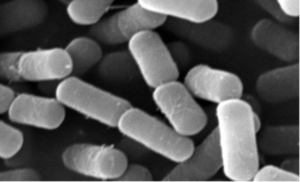
B. cereus under an electron microscope(7).
Habitat Information
Soil Sample Dig Location:
Lat:30.002092
Long:-97.883009
Soil: Castephen Clay Loam/ 3-5% slopes, eroded
Description: New housing development, empty lot
Precipitation:Not within 48 hours
Temperature:70, few clouds
Depth: 1.25 inches
Visibility: 10 miles
Humidity: 59%
Wind: S 10 mph
Sea Level: 1011.8
Date & Time: September 8, 2016, 18:53
Description and Significance
Description:
Color: Yellow (mustard-like color)
Form: Circular
Margin: Entire
Consistency: Semi-mucoid
Texture: Smooth
Elevation: Raised
- A standard Gram stain was performed on the sample to observe cellular morphology.
Gram reaction: positive
Cellular morphology: very small, clustered rods
Antibiotics
Antimicrobial Activity: Negative
Drug Resistance: B. cereus produce large amounts of β lactamase and are resistant to penicillin, ampicillin, cephalosporins, trimethoprim(8).
Significance
B. cereus can be considered significant in food manufacturing, livestock health, human disease, and pharmaceutical manufacturing.
Genome Structure
The genome of B. cereus is very similar to the genome of B. anthracis (3). B. cereus has a single, circular chromosome that is 5,411,809 nt long (4).
S Ribosomal sequences obtained from PCR:
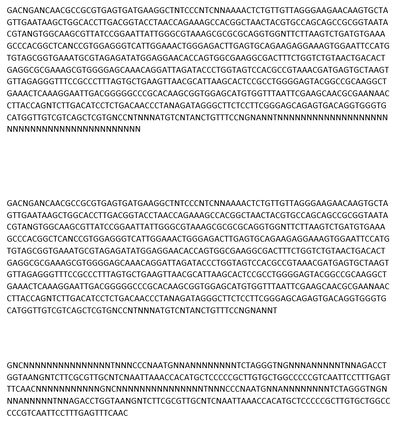
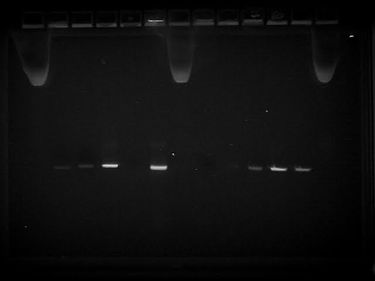
Gel Electrophoresis results from Microbiology class. Well 4 is B. cereus sample collected by Lewis and Cudmore.
Cell Structure, Metabolism and Life Cycle
B. cereus is a rod shaped, Gram positive bacteria. B. cereus is motile via flagella and produces endospores (6).
B. cereus is a facultative anaerobe. Some metabolic molecules B. cereus makes include NADH dehydrogenases, succinate dehydrogenase, complex III, non-proton-pumping cytochrome bd quinol oxidases, and proton-pumping oxidases such as cytochrome c oxidase and cytochrome aa3 quinol oxidase (5).
Other stain results:
Capsule stain: negative
Endospore stain: negative
Additional Test Results:
Gelatinase Test: Positive for Gelatinase production
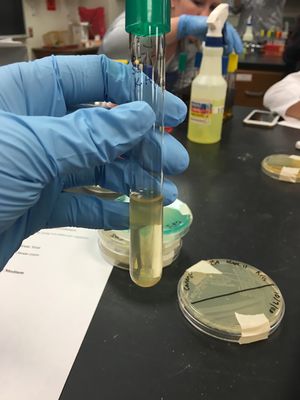
Deoxyribonuclease Test: Positive for DNAse
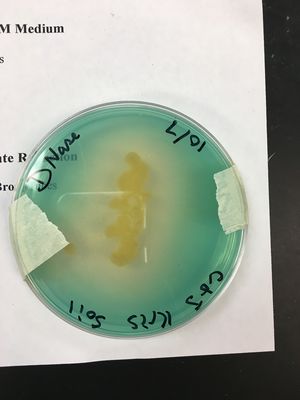
Lipase Test: Negative
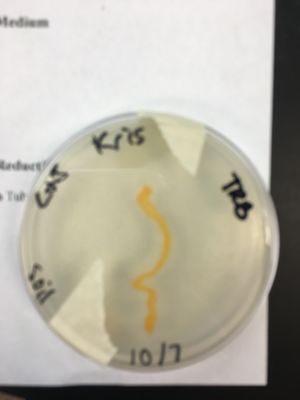
Starch Hydrolysis: Negative
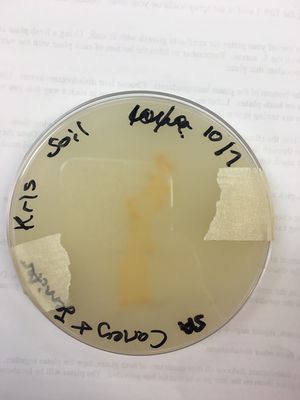
Citrate (Enteric) Test: Positive
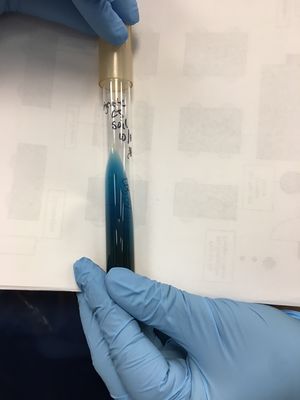
Urea Test:Negative
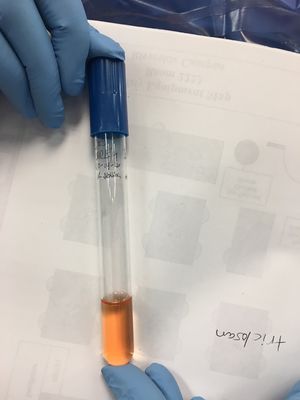
Methyl Red: Negative
Voges-Proskauer: Negative
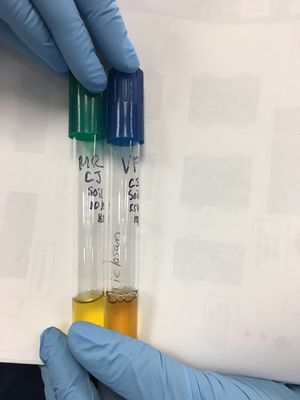
Blood Agar:(α)alpha (partial hemolysis)
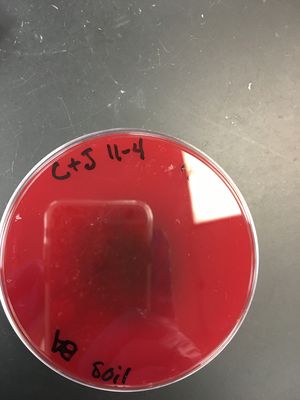
SIM Test:
- Sulfur-negative
- Indole-positive
- Motility-negative
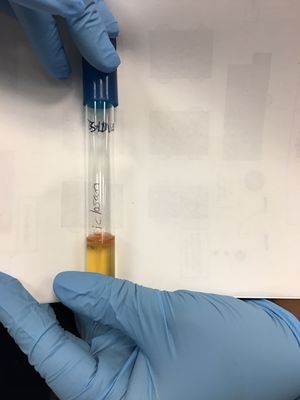
Nitrate Test: Negative for Nitrate reduction
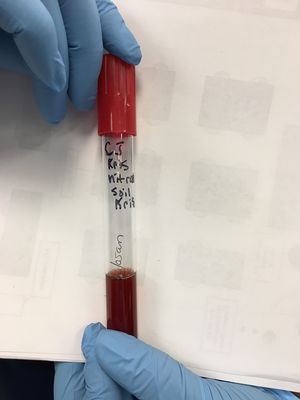
Phenylalanine Deaminase Test: Negative
Phenol Red Test:
- Lactose-Fermentation with acid/gas production
- Sucrose-fermentation with acid/gas production
- Glucose-Fermentation with acid/gas production
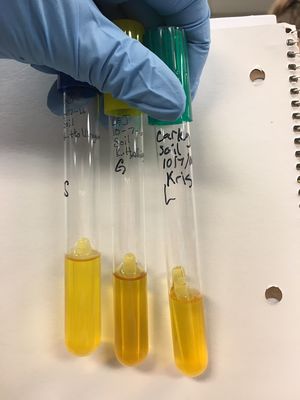
Casease Test: Positive for Casease
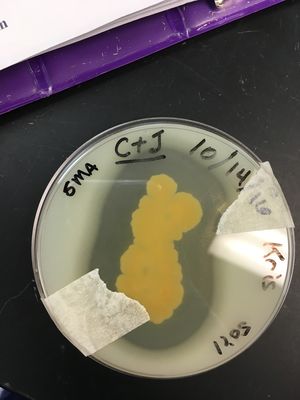
Triple Iron Sugar Agar(TSI):
- Alkaline with gas production
- Arginine-Negative
- Lysine-Positive
- Ornithine-Negative
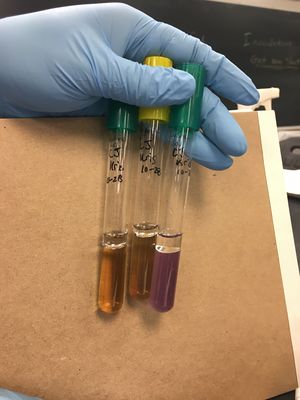
Mannitol Salt Test: Positive for Mannitol Fermentation
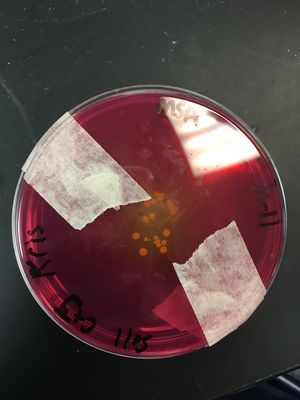
Bile Esculin Test: Positive for Esculin breakdown

6.5% Salt Tolerance Test: Positive for Salt toleration

MacConkey Agar Test: Negative
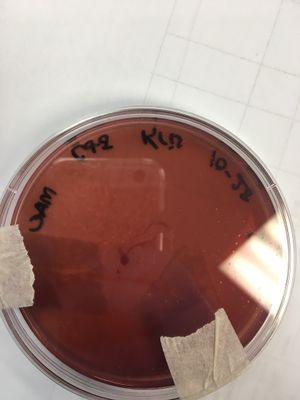
Eosin Methylene Blue: Negative
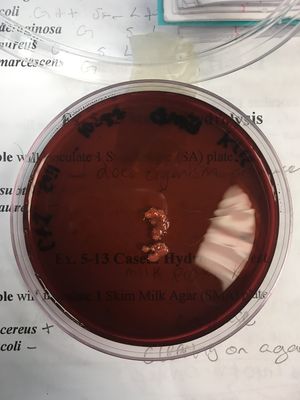
Hektoen Enteric Agar Test: Negative
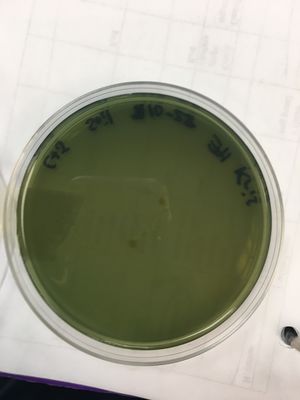
Bacitracin Susceptibility Test:
- Bacitracin (A disk)- Suceptible
- Optochin ( P disk)-Susceptible
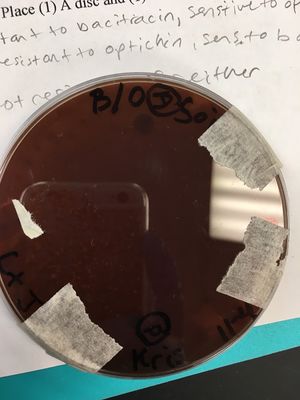
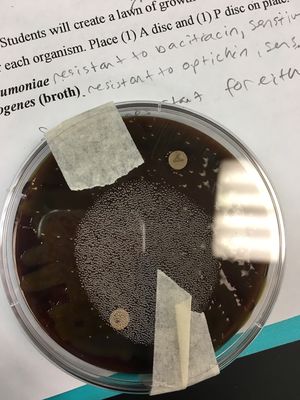
Phenylethyl Alcohol Agar (PEA):Positive
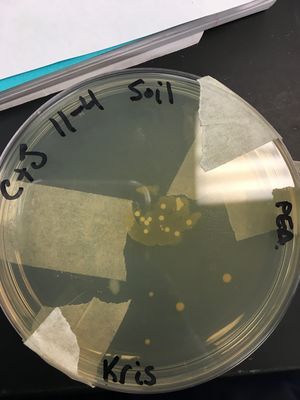
Physiology and Pathogenesis
The pathogenicity of B. cereus, whether intestinal or non-intestinal, is intimately associated with the production of tissue-destructive exoenzymes.Among these secreted toxins are four hemolysins, three distinct phospholipases, an emesis-inducing toxin, and proteases. (1)
B. cereus has been known to cause food-borne illness (most notably "fried-rice syndrome"), as well as skin infections (most commonly keratitis) in humans.
In some animals, B. cereus can be used as a probiotic.
B. cereus was found to be the most common contaminant in pharmaceutical manufacturing. (2)
References
1. Bottone, Edward J. “Bacillus Cereus, a Volatile Human Pathogen.” Clinical Microbiology Reviews 23.2 (2010): 382–398. PMC. Web. 7 Dec. 2016.
2. Sandle, Tim (28 November 2014). "The Risk of Bacillus cereus to Pharmaceutical Manufacturing". American Pharmaceutical Review (Paper). 17 (6): 56.
3. Ivanova, Natalia. "Genome sequence of Bacillus cereus and comparative analysis with Bacillus anthracis." Nature, vol. 423, 1 May 2003, pp. 87-91.
4. Rasko, D., Altherr, M., Han, C., and Ravel, J. “Genomics of the Bacillus cereus group of organisms.” FEMS Microbiology Reviews. 2005. Volume 29(2). p.303-329.
5. Duport, C., Zigha, A., Rosenfeld, E., and Schmitt, P. “Control of Enterotoxin Gene Expression in Bacillus cereus F4430/73 Involves the Redox-Sensitive ResDE Signal Transduction System.” Journal of Bacteriology. 2006. Volume 188. p. 6640–6651.
6. Senesi, S., Celandroni, F., Salvetti, S., Beecher, D., Wong, A., and Ghelardi, A. “Swarming motility in Bacillus cereus and characterization of a fliY mutant impaired in swarm cell differentiation.” Microbiology. 2002. Volume 148. p. 1785-1794.
7. http://cdn.phys.org/newman/gfx/news/hires/2013/structuralst.png
8. http://www.phac-aspc.gc.ca/lab-bio/res/psds-ftss/bacillus-cereus-eng.php
Author
Page authored by Carley Cudmore and Jennifer Lewis, students of Prof. Kristine Hollingsworth at Austin Community College.
